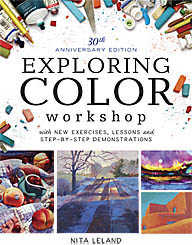Neutral colors--an oxymoron
Neutrals are achromatic, meaning they have no color. Black, gray and white. Anything else is chromatic, having color, from shocking pink to beige. At least that's how it's stated in color theory. But artists have their own ideas about neutrals and usually this means they're looking for a color bias instead of a flat black, gray or white: a bluish-black, a greenish-gray or a pinkish-white. These are more interesting than the neutrals you find in a tube of flat black or gray paint. So how do you mix exciting neutrals?
The rule in color theory is that neutral gray or black is the result of mixing two complementary (opposite) colors on the color wheel. It works in theory, but not in paint. Very few colors can be described as exact opposites and almost none are true hues in the color scheme sense. Sometimes you get black or gray when you mix, but often you get brown or umber. The paint colors are actually "near complements" and make a mixture with a bias toward one of the two colors in the mixture. This color combination makes a more vibrant mixture.
One thing to remember about mixing neutrals is to use only the colors that are already in your painting. Plan your colors before you paint to make sure you can get your full range of values, color and neutrals. Mingle the colors you've chosen. Don't decide at the last minute to throw in a tube neutral or it will stand out like a sore thumb.
The rule in color theory is that neutral gray or black is the result of mixing two complementary (opposite) colors on the color wheel. It works in theory, but not in paint. Very few colors can be described as exact opposites and almost none are true hues in the color scheme sense. Sometimes you get black or gray when you mix, but often you get brown or umber. The paint colors are actually "near complements" and make a mixture with a bias toward one of the two colors in the mixture. This color combination makes a more vibrant mixture.
One thing to remember about mixing neutrals is to use only the colors that are already in your painting. Plan your colors before you paint to make sure you can get your full range of values, color and neutrals. Mingle the colors you've chosen. Don't decide at the last minute to throw in a tube neutral or it will stand out like a sore thumb.
Labels: color, color mixing, color theory, color wheel, tutorials





2 Comments:
Hi. Just wanted to say thanks for your blog - helped me with my assignment. Hope you don't mind.
Cheers,
Jane Forrest
I have been studying color using your books for many years. In fact, I have all the books you have written on art and do wish to do a workshop with you one day. Your book, Exploring Color, is the book that I suggest to
everyone of my students as a "must buy" for their art library.
Post a Comment
<< Home